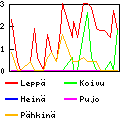DNS 1: Dynamic DNS
Traduction: [ Google | Babelfish ]
Catégories : [ Informatique ]
Now that I have my own server, I can finally have my own DNS server and my own domain name for my home computer that has a (single) dynamic IP address.
The following notes assumes there is already a running instance of Bind 9 on a
Debian Jessie system for an imaginary domain example.com, served by a name
server named ns.example.com and you want to dynamically update the DNS
records for home.example.com. This is largely based on the Debian
tutorial on the subject, solving the problem
that bind cannot modify files in /etc/bind.
On the server
Create a shared key that will allow to remotely update the dynamic zone:dnssec-keygen -a HMAC-MD5 -b 128 -r /dev/urandom -n USER DDNS_UPDATEThis creates a pair of files (
.key and .private) with names starting with
Kddns_update.+157+. Look for the value of Key: entry in the .private
file and put that value in a file named /etc/bind/ddns.key with the
following content (surrounding it with double quotes):
key DDNS_UPDATE {
algorithm HMAC-MD5.SIG-ALG.REG.INT;
secret "THIS IS WHERE YOU PUT THE KEY";
};
You can then delete the two Kddns_update.+157+ files. Ensure that
/etc/bind/ddns.key belongs to "root" and to the "bind" group, and is not
readable by other users.
Then in named.conf.local, include the key file and declare a new zone:
include "/etc/bind/ddns.key";
zone "home.example.com" {
type master;
file "/var/cache/bind/db.home.example.com";
allow-update { key DDNS_UPDATE; };
journal "/var/cache/bind/db.home.example.com.jnl";
};
In /var/cache/bind create the file db.home.example.com by copying
/etc/bind/db.empty and adapting it to your needs. For convinience, create a
db.home.example.com symbolic link in /etc/bind pointing to
/var/cache/bind/db.home.example.com.
db.example.com (that is, the parent zone), add a NS entry to delegate
the name home.example.com to the DNS server of the parent zone:
home.example.com NS ns.example.com
You can now reload the bind service to apply the configuration changes.
nsupdate.
On the home computer
I decided to use ddclient 3.8.3 because it supports dynamic dns updates
using the nsupdate tool. I backported that version of ddclient manually
from a Debian Testing package; it's written in Perl and the backporting is
trivial.
/etc/bind/ddns.key from the server to /etc/ddns.key on the home
computer (the one running ddclient), ensuring only root can read it. Then add
the following to /etc/ddclient.conf (be careful with the commas, there is no
comma at the end of the second last line):
protocol=nsupdate, \ zone=home.example.com, \ ttl=600, \ server=THE_IP_ADDRESS_OF_THE_DNS_SERVER, \ password=/etc/ddns.key \ home.example.com
You can then try out the new setup.
[ Posté le 27 avril 2016 à 18:15 | 1 commentaire | lien permanent ]






